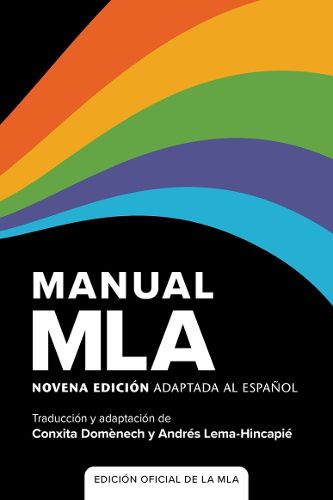Readings Newsletter
Become a Readings Member to make your shopping experience even easier.
Sign in or sign up for free!
You’re not far away from qualifying for FREE standard shipping within Australia
You’ve qualified for FREE standard shipping within Australia
The cart is loading…






Normas sencillas para escribir y citar fuentes en espanol siguiendo las directrices de la MLA Easy-to-follow standards for writing and citing sources in Spanish from the MLAGeneracion tras generacion, los escritores confian en el MLA Handbook. Publicado por la Modern Language Association, este manual es la guia ideal para redactar y documentar fuentes y el mejor recurso para toda persona que escribe trabajos de investigacion con multiples referencias a otros estudios. Con una nueva adaptacion al espanol, es la herramienta completa y necesaria para profesionales que necesitan dominar la redaccion de textos tecnicos, academicos o de negocios. Instrumento de vital ayuda para estudiantes, docentes, universitarios y bibliotecarios, el manual ofrece pautas uniformes y comprensibles para elaborar una prosa clara y atractiva, evaluar fuentes y citarlas y acreditarlas con precision, y dar formato a cualquier trabajo de investigacion. Con informacion relevante sobre_gramatica, puntuacion, mayusculas, ortografia, numeros y lenguaje inclusivo_como crear citas dentro del texto, hacer un listado de obras citadas, crear notas al pie y notas finales_como citar, parafrasear y resumir_evitar el plagioEsta edicion incluye las indicaciones precisas para dominar el espanol escrito, como el uso de los signos de puntuacion-comas de enumeracion, guiones o rayas-el uso de mayusculas en titulos y subtitulos, la estilizacion de los apellidos o la colocacion de otros signos de puntuacion en relacion con las comillas. Para ello, el Manual MLA ofrece cientos de ejemplos en espanol: citas de libros, articulos de revistas, sitios webs, peliculas y programas de television.
Generations of writers have relied on the MLA Handbook, published by the Modern Language Association, for guidance on writing and on documenting sources. This new Spanish adaptation of the handbook is a comprehensive resource for Spanish-language writers of research papers and anyone citing sources, from business writers, technical writers, and editors to student writers and the teachers and librarians working with them. It establishes uniform, easy-to-follow guidelines that help writers craft clear and engaging prose, evaluate sources and accurately cite and credit them, and format research papers. It includes information on_grammar, punctuation, capitalization, spelling, numbers, and inclusive language_creating in-text citations, the list of works cited, and footnotes and endnotes_quoting, paraphrasing, and summarizing_avoiding plagiarism.
Guidance unique to this edition includes matters of punctuation in Spanish, from the serial comma to hyphens and dashes; capitalizing titles and subtitles in Spanish and styling Spanish surnames; the placement of other punctuation marks in relation to quotation marks; and more. In the Manual MLA, readers will find hundreds of new Spanish-language examples-including citations for books, journal articles, websites, films, and television shows.
$9.00 standard shipping within Australia
FREE standard shipping within Australia for orders over $100.00
Express & International shipping calculated at checkout
Normas sencillas para escribir y citar fuentes en espanol siguiendo las directrices de la MLA Easy-to-follow standards for writing and citing sources in Spanish from the MLAGeneracion tras generacion, los escritores confian en el MLA Handbook. Publicado por la Modern Language Association, este manual es la guia ideal para redactar y documentar fuentes y el mejor recurso para toda persona que escribe trabajos de investigacion con multiples referencias a otros estudios. Con una nueva adaptacion al espanol, es la herramienta completa y necesaria para profesionales que necesitan dominar la redaccion de textos tecnicos, academicos o de negocios. Instrumento de vital ayuda para estudiantes, docentes, universitarios y bibliotecarios, el manual ofrece pautas uniformes y comprensibles para elaborar una prosa clara y atractiva, evaluar fuentes y citarlas y acreditarlas con precision, y dar formato a cualquier trabajo de investigacion. Con informacion relevante sobre_gramatica, puntuacion, mayusculas, ortografia, numeros y lenguaje inclusivo_como crear citas dentro del texto, hacer un listado de obras citadas, crear notas al pie y notas finales_como citar, parafrasear y resumir_evitar el plagioEsta edicion incluye las indicaciones precisas para dominar el espanol escrito, como el uso de los signos de puntuacion-comas de enumeracion, guiones o rayas-el uso de mayusculas en titulos y subtitulos, la estilizacion de los apellidos o la colocacion de otros signos de puntuacion en relacion con las comillas. Para ello, el Manual MLA ofrece cientos de ejemplos en espanol: citas de libros, articulos de revistas, sitios webs, peliculas y programas de television.
Generations of writers have relied on the MLA Handbook, published by the Modern Language Association, for guidance on writing and on documenting sources. This new Spanish adaptation of the handbook is a comprehensive resource for Spanish-language writers of research papers and anyone citing sources, from business writers, technical writers, and editors to student writers and the teachers and librarians working with them. It establishes uniform, easy-to-follow guidelines that help writers craft clear and engaging prose, evaluate sources and accurately cite and credit them, and format research papers. It includes information on_grammar, punctuation, capitalization, spelling, numbers, and inclusive language_creating in-text citations, the list of works cited, and footnotes and endnotes_quoting, paraphrasing, and summarizing_avoiding plagiarism.
Guidance unique to this edition includes matters of punctuation in Spanish, from the serial comma to hyphens and dashes; capitalizing titles and subtitles in Spanish and styling Spanish surnames; the placement of other punctuation marks in relation to quotation marks; and more. In the Manual MLA, readers will find hundreds of new Spanish-language examples-including citations for books, journal articles, websites, films, and television shows.